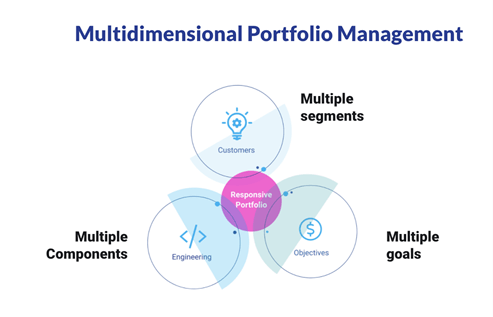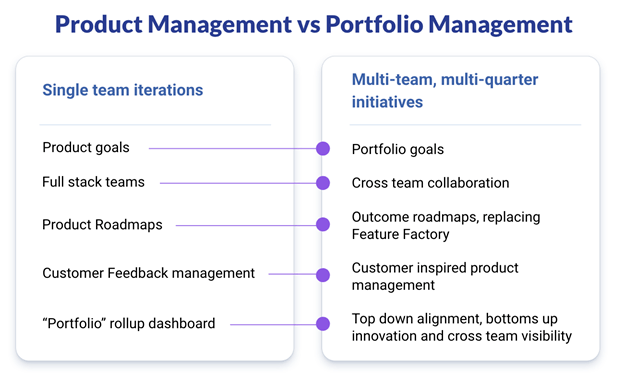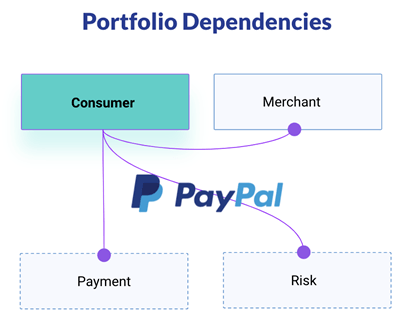Uplevel Product Management with Portfolio Management for Outcome Focused Product Leaders

You’ve achieved product market fit. Your team is growing, and business is expanding. Chaos and misalignment start to creep up. But it’s normal, right? Startups are supposed to have a bit of “messiness” and growing pains, right?
Right, but only to a small extent. Without a framework for scaled operations, the ever-increasing chaos, misalignment, and silos can quickly stall growth, confuse customers, and harm your business. With today’s fast-moving market and distributed teams, the margin for error is narrowing quickly.
As a follow-up to the 3-part webinar series, Product Management Is Not Enough For ScaleUp CPOs, we will dig deeper into key questions about portfolio management. We’ll cover when and how to bring responsive portfolio management to your evolving organization, so that you can effectively scale teams, deliver results, expand to new markets, and innovate quickly.
We have only 1 product. How does portfolio management apply?
Many product leaders think that since their company has only one product, portfolio management does not apply. But in reality, portfolio management skills are needed in product teams and organizations of all sizes, because of the “one product” portfolio phenomenon in the era of digital products.
A traditional product portfolio refers to a selection of products that users can separately acquire and use. Examples include Procter & Gamble’s shampoo brands or a bank's savings and checking products. A digital product, such as PayPal, may appear to be one product for a single user, but it is actually different “products” for different types of users. PayPal’s product for a consumer to pay online is different from the product for a merchant to run their business.
The principle behind portfolio management is about assessing investment choices. Therefore, every product team runs a multi-dimensional portfolio that needs to support:
- Multiple goals
- Multiple investment categories (innovation, existing products, infrastructure, etc.)
- Multiple customer segments
- Multiple product / strategic themes

Regardless of whether you have 1 product or multiple products, you need to take a product portfolio management approach to lead your product organization – as soon as you reach product market fit.
Product Portfolio Management is about how a product leader decides how much investment to allocate to each dimension to achieve the best collective outcomes, i.e., portfolio outcomes.
What’s the difference between product management and portfolio management?
Product management enables innovation and problem solving for customer needs, where portfolio management ensures strategic alignment and allocation to maximize portfolio outcomes.
Core product management skills include assessing customer needs, product discovery, product design, planning, building, and shipping product features.
Portfolio management skills include strategic planning, forecasting, allocation, trade-off analysis, scenario planning, and adjustment (re/balancing).

The portfolio management approach enables product leaders to bring both incremental and transformational products to market and achieve near-term results while moving towards long- term vision.
Outcome-focused product organizations need both portfolio management skills AND product management skills to ensure top-down alignment, bottom-up innovation, as well as collaboration across the portfolio, across teams, and across functions.
When does portfolio management become essential?
Modern software can’t be built by 1 team. If you are planning quarter by quarter, team by team, or feature by feature, as opposed to thinking about multi-quarter, multi-team initiatives, you are in serious need of adopting portfolio management.
Here are a couple of observable symptoms of a product organization that is in need of portfolio management to take the company to the next level and stay competitive in the market.
Symptom #1 - Isolated teams each have their own vision and strategy
Have you ever come across “org-chart-driven product development” where you can experience incoherent product design from page to page or module to module? Or run into bottlenecks in your organization because “that team owns that service and nobody else can modify it”? Peek inside the organization, and you will likely see disconnected teams. In order to fit work within each team, companies break down work into small enough chunks, so that they can be self-contained in 1-2 teams. Or the teams produce work-arounds to avoid being “held up” by other teams (dependencies).
The “peanut butter strategy” from Yahoo is a prime example of how isolated teams or business verticals prohibit focused investment in bigger initiatives (“bets”) that may lead to meaningful portfolio impact.
Symptom #2 – Feedback-driven product management
While sales and customer input driving product roadmaps can provide insight to what’s slightly ahead, it does not encourage breakthrough product concepts needed for companies that have reached initial product market fit.
Chasing near-term revenue from existing customers while delaying investment in new products prevents the future growth of the company. Finding the next product takes time and experimentation.
A telltale sign of an organization in urgent need of portfolio management is when it does not have multi-quarter, multi-team initiatives, post product market fit.
Portfolio management sounds very top-heavy. How does it work in an empowered team culture?
Leaders want to empower teams. They feel too much management will stall innovation, but the truth is:
“Empowered teams do not need less management. They need better management.” Marty Cagan, Empowered.
The old “command and control” project portfolio management style has managers defining strategies and outputs (lists of features with dates) for their teams, leaving the teams to just execute the plan, on time and on budget. This is indeed top-heavy, and not empowering.
The modern Responsive Product Portfolio Management (RPPM) style adopts an approach of top-down alignment, bottom-up innovation, and collaboration across teams and functions.
In RPPM, leaders clarify a set of goals, align on the strategic approaches (aka initiatives) to achieve these goals, and agree upon resource allocation towards these initiatives. This process is known as Strategic Planning.
The output of this process is a set of problems for teams to solve, the strategic context for decision making, and resources needed within and across dependent teams. Armed with these essential ingredients, teams are both empowered and enabled to innovate and build products that solve customer problems and achieve business outcomes. (see Rock, Pebble, Sand portfolio management)
What’s the best way to structure teams when leading a portfolio?
Every scaling company/ CXO I’ve worked with has had questions about team structure. Team structure needs to account for how the rest of the organization interacts with the team, as well as how efficiently teams work together. Some common team structures include component teams, full stack teams, mission teams, customer journey teams, or hybrid matrix teams with multiple structure formats.
While all these structures have pros and cons, the reality is that no matter how you structure your teams, you will face two inherent challenges due to scale:
- Your team structure will continuously change as you grow and adjust.
- Teams will always have to work together for cross-team initiatives and shared goals.

So in addition to getting the structure in place so that everyone in the company, in general, knows who to reach out to, you also need to enable effective cross-team work (aka managing dependencies and shared goals) in a constantly changing organization. Interestingly, team structure and design fit squarely into the realm of product portfolio management. How so? Because PPM concerns itself with work and information flows across products and teams in addition to investment decisions. The best investment choices are unimportant if you don’t have the human system organized effectively to deliver.
How do I bring portfolio management to our organization?
One key truth is that even if we aren’t calling it “portfolio management,” most companies are practicing it as they make decisions about what to work on, when, and for how long. However, only a small portion of businesses are doing it effectively. Adopting RPPM goes hand in hand with building an outcome-focused organization. There are 3 elements that will enable your team to build an effective outcome focused portfolio.
Change Agent/Champion: Start with identifying a change agent and champion both at the executive level, (e.g., Chief Product Officer or VP of Product), and at the team level (e.g., product operations or a director of product). They were most likely brought in to scale and take the product organization to the next level.
Product Operations Skills: Adopting portfolio management practices often coincides with implementing more consistent product operations practices like OKR alignment, strategic and quarterly planning, release processes, and GTM alignment. The right product operations skills, either carried out by a dedicated product ops manager, or by someone wearing this “hat,” are critical to help product teams scale effectively.
Tooling: Because there are so many moving pieces, building products across teams requires effective alignment, collaboration, and a source of truth that facilitates decisions and improves processes. A purpose-built Responsive PPM tool like Dragonboat enables effective connection between leaders and teams, outcomes, and roadmaps via its built-in best practices and seamless integration with up- and down-stream tools for data-driven, outcome-focused product portfolio management.
Summary
Building an outcome-focused product organization requires aligning goals and strategies with resources and execution, while simultaneously evaluating and adjusting focus and allocation based on your targeted outcome and the state of the market. Effective product organizations need collaboration between leaders and teams, across teams, as well as across other functions in the company. This is called Responsive Product Portfolio Management, and it is essential for every product leader in today’s fast moving environment. Learn more at Dragonboat.io and ResponsivePPM.org.









